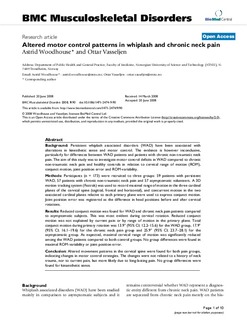| dc.contributor.author | Woodhouse, Astrid | |
| dc.contributor.author | Vasseljen, Ottar | |
| dc.date.accessioned | 2015-09-21T13:00:11Z | |
| dc.date.accessioned | 2016-06-15T10:32:48Z | |
| dc.date.available | 2015-09-21T13:00:11Z | |
| dc.date.available | 2016-06-15T10:32:48Z | |
| dc.date.issued | 2008-06-20 | |
| dc.identifier.citation | BMC Musculoskeletal Disorders 2008, 9(90) | nb_NO |
| dc.identifier.issn | 1471-2474 | |
| dc.identifier.uri | http://hdl.handle.net/11250/2392670 | |
| dc.description.abstract | Background
Persistent whiplash associated disorders (WAD) have been associated with alterations in kinesthetic sense and motor control. The evidence is however inconclusive, particularly for differences between WAD patients and patients with chronic non-traumatic neck pain. The aim of this study was to investigate motor control deficits in WAD compared to chronic non-traumatic neck pain and healthy controls in relation to cervical range of motion (ROM), conjunct motion, joint position error and ROM-variability.
Methods
Participants (n = 173) were recruited to three groups: 59 patients with persistent WAD, 57 patients with chronic non-traumatic neck pain and 57 asymptomatic volunteers. A 3D motion tracking system (Fastrak) was used to record maximal range of motion in the three cardinal planes of the cervical spine (sagittal, frontal and horizontal), and concurrent motion in the two associated cardinal planes relative to each primary plane were used to express conjunct motion. Joint position error was registered as the difference in head positions before and after cervical rotations.
Results
Reduced conjunct motion was found for WAD and chronic neck pain patients compared to asymptomatic subjects. This was most evident during cervical rotation. Reduced conjunct motion was not explained by current pain or by range of motion in the primary plane. Total conjunct motion during primary rotation was 13.9° (95% CI; 12.2–15.6) for the WAD group, 17.9° (95% CI; 16.1–19.6) for the chronic neck pain group and 25.9° (95% CI; 23.7–28.1) for the asymptomatic group. As expected, maximal cervical range of motion was significantly reduced among the WAD patients compared to both control groups. No group differences were found in maximal ROM-variability or joint position error.
Conclusion
Altered movement patterns in the cervical spine were found for both pain groups, indicating changes in motor control strategies. The changes were not related to a history of neck trauma, nor to current pain, but more likely due to long-lasting pain. No group differences were found for kinaesthetic sense. | nb_NO |
| dc.language.iso | eng | nb_NO |
| dc.publisher | BioMed Central | nb_NO |
| dc.rights | Navngivelse 3.0 Norge | * |
| dc.rights.uri | http://creativecommons.org/licenses/by/3.0/no/ | * |
| dc.title | Altered motor control patterns in whiplash and chronic neck pain | nb_NO |
| dc.type | Journal article | nb_NO |
| dc.type | Peer reviewed | nb_NO |
| dc.date.updated | 2015-09-21T13:00:10Z | |
| dc.source.volume | 9 | nb_NO |
| dc.source.journal | BMC Musculoskeletal Disorders | nb_NO |
| dc.source.issue | 90 | nb_NO |
| dc.identifier.doi | 10.1186/1471-2474-9-90 | |
| dc.identifier.cristin | 336875 | |
| dc.description.localcode | © 2008 Woodhouse and Vasseljen; licensee BioMed Central Ltd. This is an Open Access article distributed under the terms of the Creative Commons Attribution License (http://creativecommons.org/licenses/by/2.0), which permits unrestricted use, distribution, and reproduction in any medium, provided the original work is properly cited. | nb_NO |

